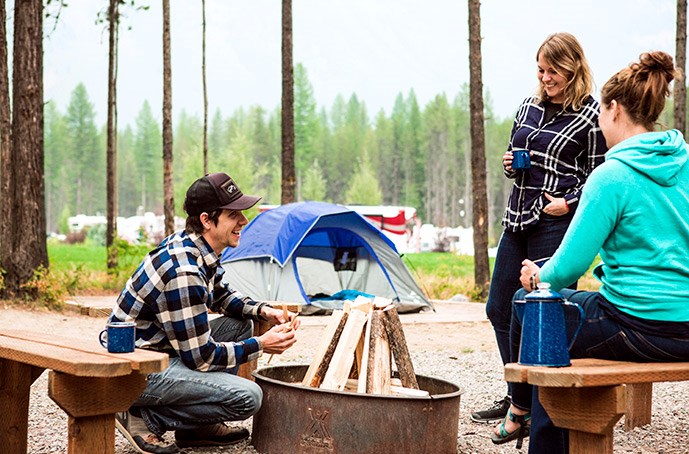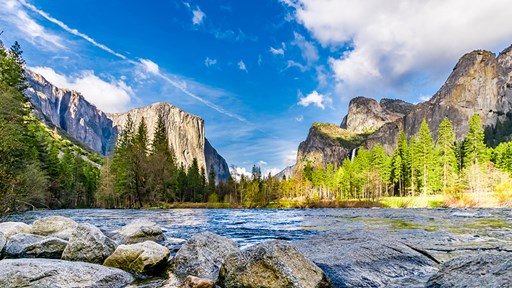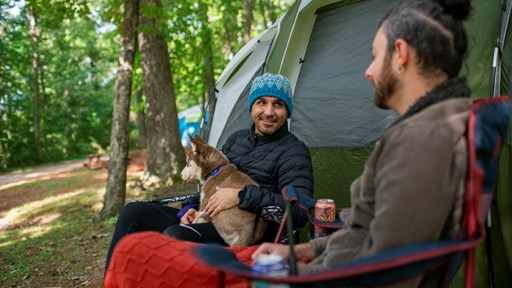26 Camping Hacks And Tips That Will Improve Any Camping Trip
As you venture into the great outdoors, make life a little easier with a few simple camping hacks. These camper hacks and tricks can help keep you clean, warm, safe and happy, creating the ideal vacation experience.
Use These Camping Tips, Tricks and Hacks to Make Your Next Great Outdoors Adventure Easier
Camping connects you with the quiet majesty of nature, allowing you to recharge your batteries and relax with family and friends. For some, “roughing it” is all part of the fun — but why not allow a bit of homespun ingenuity to make things easier for you on your next camping trip?
Here are some of the top camping hacks to take along for the weekend. These camping tips and tricks are crafty, and they are also easy to implement. Best of all, many of them will save you space, time, weight and money.
1. Make a Lantern Out of a Headlamp and a Jug of Water
All you need is your headlamp and a gallon water jug or a large water bottle. Any translucent bottle will do, but the coolest effect comes from the type of plastic that is not entirely transparent but rather a slightly cloudy color allowing you to see water sloshing around inside.
When it gets dark, strap the headlamp to the side of the jug so the beam is facing inward. The water container transforms into a glowing orb that casts light in all directions! This effect works because the water in the jug spreads the glow, which is dispersed further by the milky plastic of the container.
This makeshift lantern works great anywhere you need ambient light. Whether you need to look for something inside your tent, clean up the picnic table or start a campfire, your night just became a lot easier.
2. Glue Sandpaper Inside the Top of Your Match Holder for Easy Lighting and Waterproofing
Matches are an indispensable item when camping, but it seems all too often, things go wrong with them. They get wet, the case gets soggy or the strike pad wears down until it is smooth. This camping hack ensures your matches will be ready to strike when you need them.
Buy fine-grained sandpaper, preferably with adhesive on one side, to stick it to the matchbox. If not, some glue will do the trick. Attach the sandpaper inside the lid of a small waterproof container that will hold your matches.
The sandpaper will provide a large, coarse surface for striking, and the waterproof container will protect it. No more soggy matches or wet or worn-out strike pad!
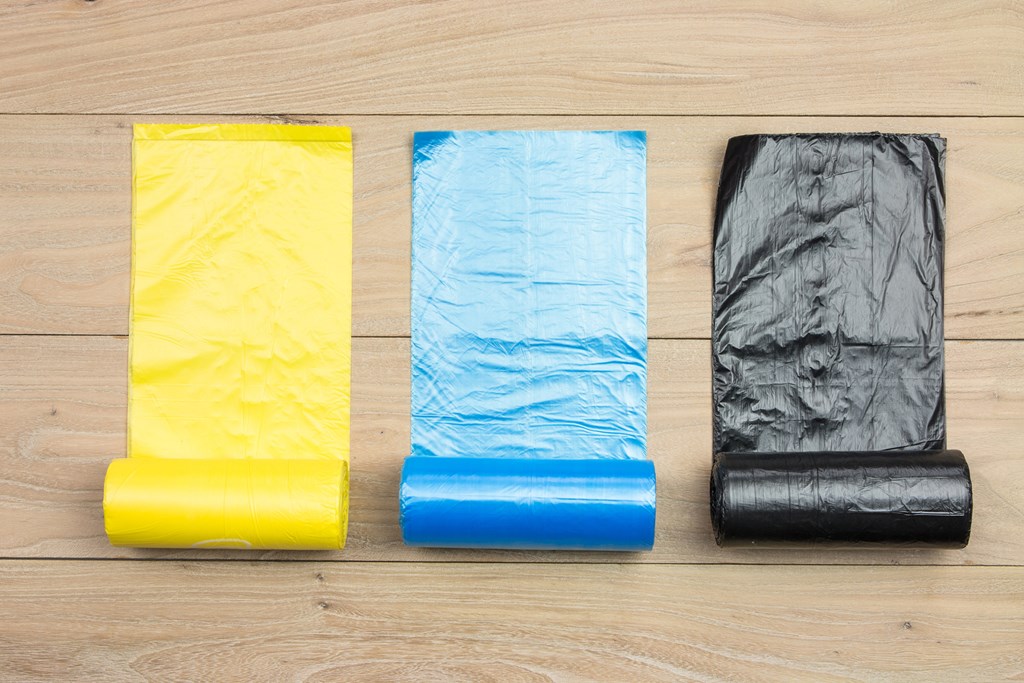
3. Line Your Bag with a Garbage Bag to Keep the Contents Dry
Weather is everything when camping, and a seasoned camper knows you can never be too prepared for Mother Nature’s fickle moods. Once you are warm and dry inside your tent, there is nothing to worry about — unless you struggle to get warm or dry because your bag and all of its contents got soaked in the rain.
This trick offers the ultimate cost-to-benefit ratio: a single trash bag in exchange for warmth and dryness. Line the inside of your backpack with a trash bag before placing all your items into it. For the cost of a trash bag — somewhere between a nickel and a dime — you have dry clothes and a dry sleeping bag for your trip, guaranteed.
Avoiding wet clothing is crucial for your comfort and safety. Wet clothing can cause you to get chilled very quickly, which can lead to illness, so take this simple step to avoid this issue!
4. Use Silica Gel Packets to Keep Your Camp Cookware Rust-Free Between Uses
You know those silica gel packets that seem to appear in every product? They are quite useful for sucking up moisture, especially in items that tend to rust. Buy a pack of them, or collect them from whatever packages you buy, as they may save your cookware.
In an ideal world, you would dry your cookware completely and store it in a moisture-free environment between uses. But weather changes, basements grow damp, and sometimes dishes must be dried in a rush before you stuff them in your bags — and that is where silica gel packets come in.
Using these packets keeps moisture from rusting away your cookware between uses. It is disappointing to pull out your favorite bowl or skillet and find it spotted with rust, and this little trick will prevent that altogether.

5. Pack Lighter by Using a Sleeping Bag Case Stuffed with Clothes as Your Pillow
Pillows are a matter of personal preference. You may prefer yours soft or firm, feather or fluff, Tempur-Pedic® or light foam.
However, pillows take up a significant amount of space in packing. Companies have developed inflatable pillows that roll into impressively small spaces, but rolling around on air is rarely very comfortable. This situation often leaves you stuffing a pillow into your bag that takes up as much space as your clothing.
To form the ultimate camping pillow, take the case for your sleeping bag and stuff it full of your softest clothing. Make sure the sleeves are unrolled and socks are not too tightly balled up so there are no pressure points, and shape the pillow to your liking. If you desire more support, add more clothing! You will love the fact that you have saved so much space in your bag.
6. Bring Bread Tags to Use as Clothespins
Bread tags are one of the most underappreciated products around. They diligently hold bread bags closed but rarely see any other purpose before being cast away. So next time you finish a loaf of bread, try them as clothespins on your next camping trip.
This tip is one of the best family camping hacks since bringing enough clothespins for a family’s laundry can steal a good amount of real estate inside a bag. Bread tags are not only cheap, but they also take up minimal space in your pack.
So set a little dish aside and start collecting those bread tags. They will soon be doing their work in the sunshine, drying your clothes and keeping them securely fixed to the line.
7. Make a Makeshift Grommet by Tying Line Around a Rock Wrapped in a Tarp
Bread tags are one of the most underappreciated products around. They diligently hold bread bags closed but rarely see any other purpose before being cast away. So next time you finish a loaf of bread, try them as clothespins on your next camping trip.
This tip is one of the best family camping hacks since bringing enough clothespins for a family’s laundry can steal a good amount of real estate inside a bag. Bread tags are not only cheap, but they also take up minimal space in your pack.
So set a little dish aside and start collecting those bread tags. They will soon be doing their work in the sunshine, drying your clothes and keeping them securely fixed to the line.
8. Use Gallon Jugs of Water as Ice Packs in Your Cooler
Bringing ice on a camping trip can be difficult. It melts quickly and becomes a watery mess, meaning any nonplastic food packaging will soon become soaked and soggy.
As an alternative to pouring ice into your cooler, freeze gallon jugs of water and put them in instead. They will not crack when frozen, and these jugs have built-in room for expansion in freezing. As the ice warms and turns into water, you will have drinking water ready without having to haul extra. Have smaller space? This hack works with individual bottles too!
There are two things to remember when packing water for a camping trip: water is essential, and it is also heavy. Therefore, pack more than enough drinking water, but try not to pack water that will go to waste — like ice that will soon melt and become undrinkable. This hack addresses both points simultaneously by allowing your ice to become extra drinking water after it has done its job of keeping your food cold.
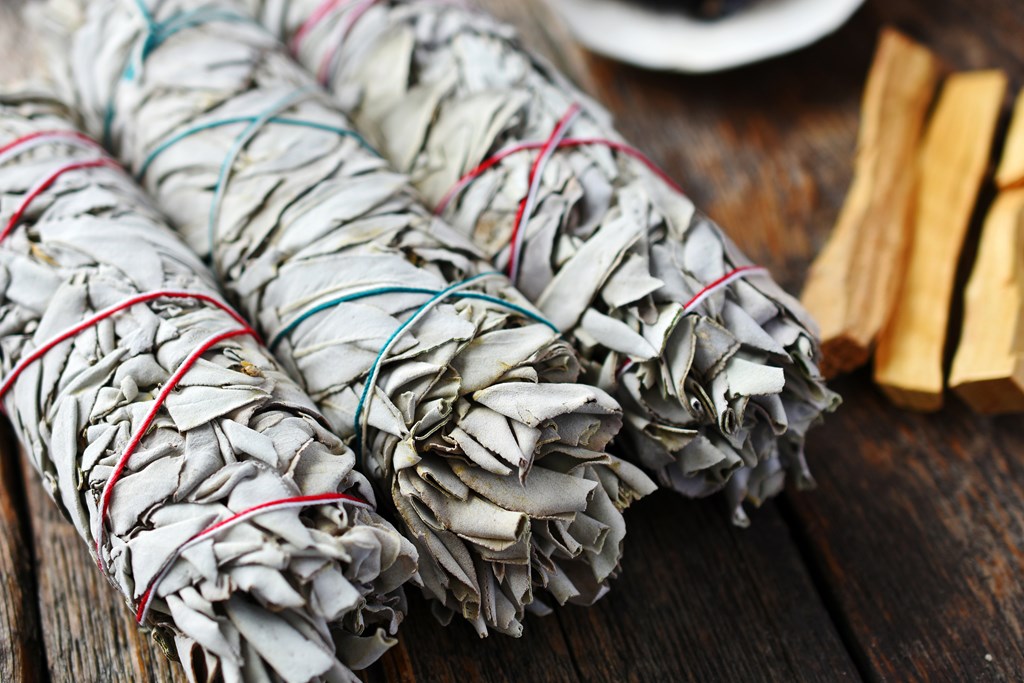
9. Burn Sage in Your Campfire to Help Repel Mosquitoes
Mosquitoes can dampen an otherwise excellent camping experience. Knowing how to repel them, even without slathering yourself in hazardous levels of bug repellent, is a great skill when camping.
Take along a few bundles of sage the next time you go camping. When the sun is setting and the campfire is going, burn a bit of sage with your fire. For a longer-lasting effect, set the sage on fire and let it smolder and smoke by the edge of the campfire. Mosquitoes are naturally repelled by sage smoke, and you will find fewer buzzing around you.
Remember that mosquitoes, while present at all times of day, are typically most active at dawn and dusk. It is best to prepare by having some burning sage ready at those times.
10. Corn Chips and Doritos Make Great Kindling Instead of Small Sticks
There are times when good kindling just is not easy to find, and you eye those poor, undeserving items in your camping arsenal as flammable candidates. But there is good news — a handful of Doritos will do a beautiful job of starting a fire.
You may wonder how a food like Doritos could burst into flame when lit. It turns out the starches, chemicals, oils and flavors comprising this snack make it a prime candidate for combustion, and it will work wonders at starting a fire.
While Doritos work the best, most corn chips will suffice in a pinch. The corn oil in these chips is flammable and provides a steady burn allowing you to start your fire.
11. Melt and Seal Straw Sections to Store Spices and Other Small Ingredients
This one takes more preparation than simply throwing some ill-fated Doritos into your bag, but it is an immense space saver and makes camping trips easier in packing and unpacking.
Culinary skills are often limited in the woods by a lack of seasonings and spices. No one sells travel pouches of curry powder, chili powder or rosemary, so you might settle for bottles of salt and pepper.
This hack involves cutting plastic straws into short segments, melting one end with a candle and filling the straw piece up with a spice of your choice. If you want more of the ingredient, cut a longer length of straw. Seal the other end, and voila — you have a waterproof, ultra-portable selection of spices at hand in the woods.

12. Crack Eggs Ahead of Time and Store Them in a Water Bottle for an Easy Breakfast
Bringing eggs on a camping trip is risky business. If they crack, you lose the eggs and have a mess to contend with.
Try this campfire cooking hack instead. Crack eggs beforehand and store them in a water bottle. Do this in many different ways. If you know everyone will prefer scrambled eggs, whip the eggs and store them in a large water bottle — even add milk, cheese and seasonings if you would prefer.
If you have a water bottle with a slightly larger opening, you could gently crack eggs into it for fried eggs with intact yolks. Take several bottles for different meals, or use a larger bottle to pour repeatedly.
Be sure to store these in your cooler so they will not spoil, and enjoy the ease of not toting fragile eggshells with you.
13. Fill a Bottle with Hot Water and Put It in the Foot of Your Sleeping Bag
This trick takes advantage of the heat-storing capabilities of water — this time, to bring some heat to your most remote extremities: your feet.
Feet seem to be the last part of the body to warm up when snuggling into a sleeping bag. To combat this, fill your reusable water bottle with hot water just before you retire for the evening. Toss it into the foot of your sleeping bag and enjoy its long-lasting warmth.
Use a good-quality water bottle, as waking up to a wet bag is no fun. Furthermore, if the hard plastic of your water bottle distracts you from falling asleep, try burying it in a couple of shirts to soften its presence in your sleeping bag.
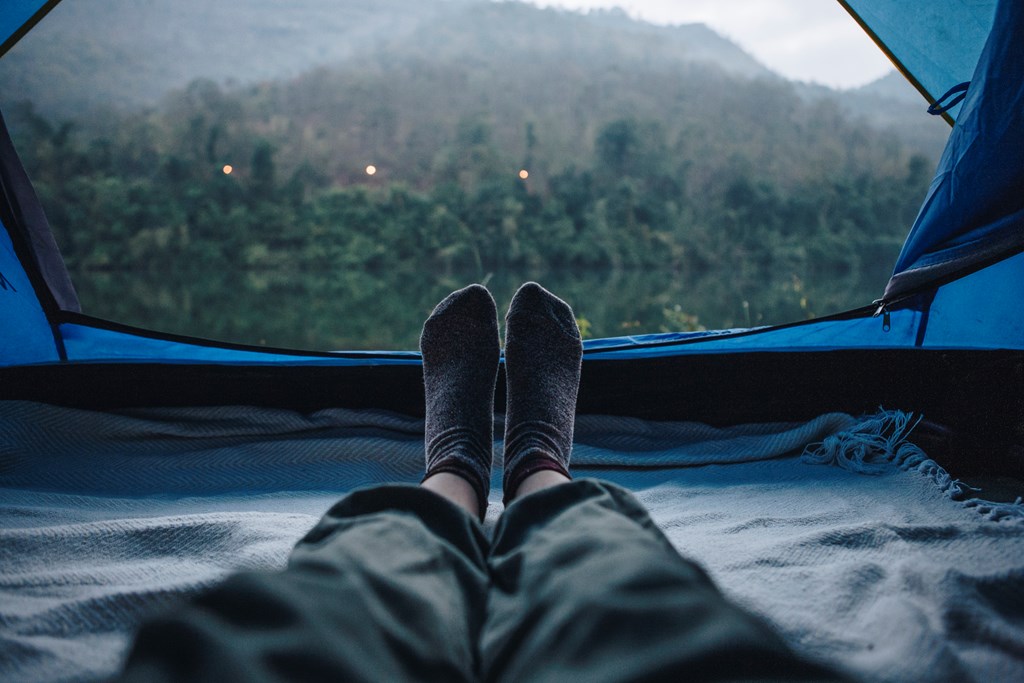
14. Keep a Pair of Socks for Sleeping Only
It is hard to explain the mental and emotional comfort of a clean pair of socks. Putting one on can lift your morale tremendously. If you prefer to sleep in socks, try keeping one pair at hand for sleeping only. They do not have to be thick hiking socks — even thin ankle socks will do.
Even if you can’t shower, having a clean and dry pair of socks on while you sleep will help your body differentiate between the day’s activities and the nighttime solace. Wearing them will not only be more comfortable, but it will also keep the dust, dirt, bark, splinters, pine needles and whatever else is attached to your socks from entering your sleeping bag.
15. Dry Your Shoes Overnight by Removing the Insoles and Inserting Dirty Clothes into Them
Wet shoes cause serious discomfort while camping. If you are anywhere humid, drying them out can also be challenging.
Try removing the insoles from your shoes and setting them aside, then stuffing some dry, used clothing into the shoes themselves. Remember that moisture naturally spreads from wet to dry places, meaning the water from your sneakers will transfer into the dry clothing.
In the morning, dry the wet clothing by hanging it by the fire or strapping it on the back of your backpack to air dry.
16. Use Frisbees as Plates
Did you or a camping companion forget a plate? Fear not — give your Frisbee a quick wash, flip it over and pile on the helpings. The lip of the Frisbee will keep any sauces in your food contained, and at the end of your meal, it returns to its original purpose.
In fact, why not bring several Frisbees instead of hauling disposable plates? They may not be quite as space-efficient, but they can be a lot more fun, and they serve dual purposes. Each member of the camping trip can carry their own Frisbee to balance out the load.
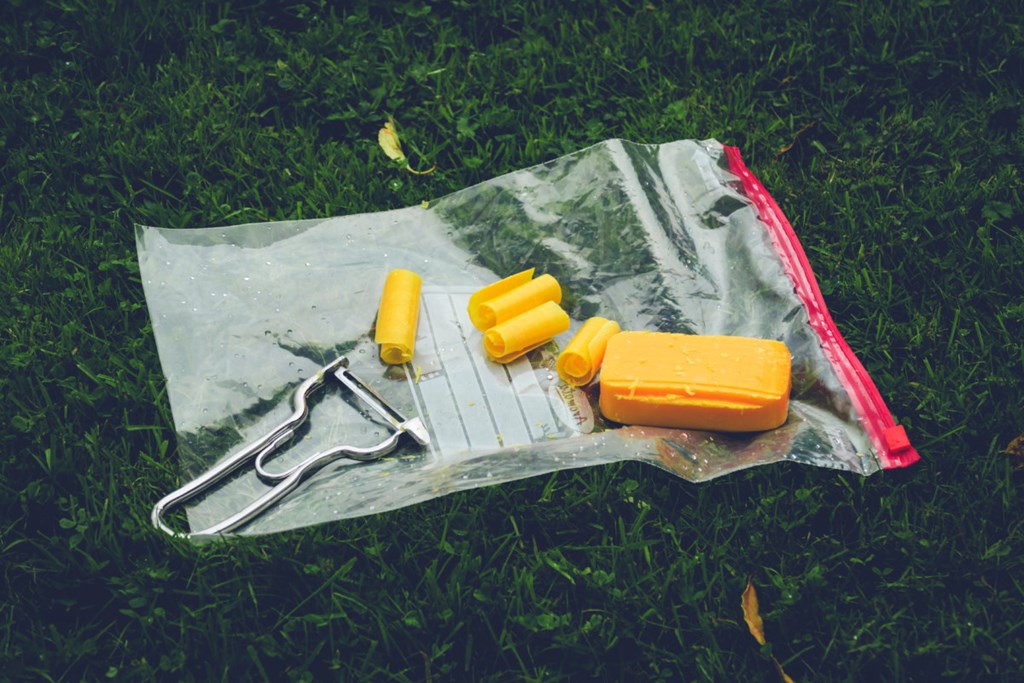
17. Use a Vegetable Peeler to Shave Strips of Soap for Single Uses
A bar of soap is wonderful until you have to put it back in your bag. This situation usually ends with something in your bag getting soapy that was not intended to be. If you keep it inside a separate plastic bag, you get a lot of soapy bubbles and wetness.
A convenient fix for the problem is using a vegetable peeler to slice off strips of soap to use each time you bathe. Store these in a single bag and grab one before heading off to shower. Also, grab one to wash your hands.
18. Loop Your Belt Around a Tree and Hang Some Hooks from it to Dry Your Cookware
Nighttime is for sleeping and recharging for the next day. If you are a camper, you know the evening is also for drying stuff out — shoes, clothes, bags and, yes, cookware. Silica gel packets wick water away from your pots and pans between uses. This nifty little camping hack will allow those pots and pans to dry overnight, making rust an even less likely scenario.
Take your belt and loop it around a tree. Attach several pot-hanger hooks — some larger S hooks work wonderfully — to the belt. Buy these almost anywhere that sells pots and pans or at your local hardware store. Hang your pots from the tree to dry overnight. Note that you should hang pots with the cooking surface facing away from the bark, as this will discourage any bugs from making a temporary home inside them.
19. Buy a Double Sleeping Bag
If you share a tent with your partner or someone you do not mind being in the same sleeping bag with, a duo sleeping bag is an excellent investment. Body heat keeps you warm at night, and a sleeping bag reflects and retains body heat. Therefore, one bag with two furnaces inside it is much better than two separate bags.
Sleeping bags are generally synthetic fluff or down feathers, and each has its respective perks and disadvantages. Synthetic is cheaper and dries quickly but takes up quite a bit of room. Down sleeping bags are costlier and retain moisture but can compress into tiny shapes for packing and are generally warmer. A twin sleeping bag filled with down will keep you warmer and can be stuffed into a small, portable sack to make transporting it a breeze.
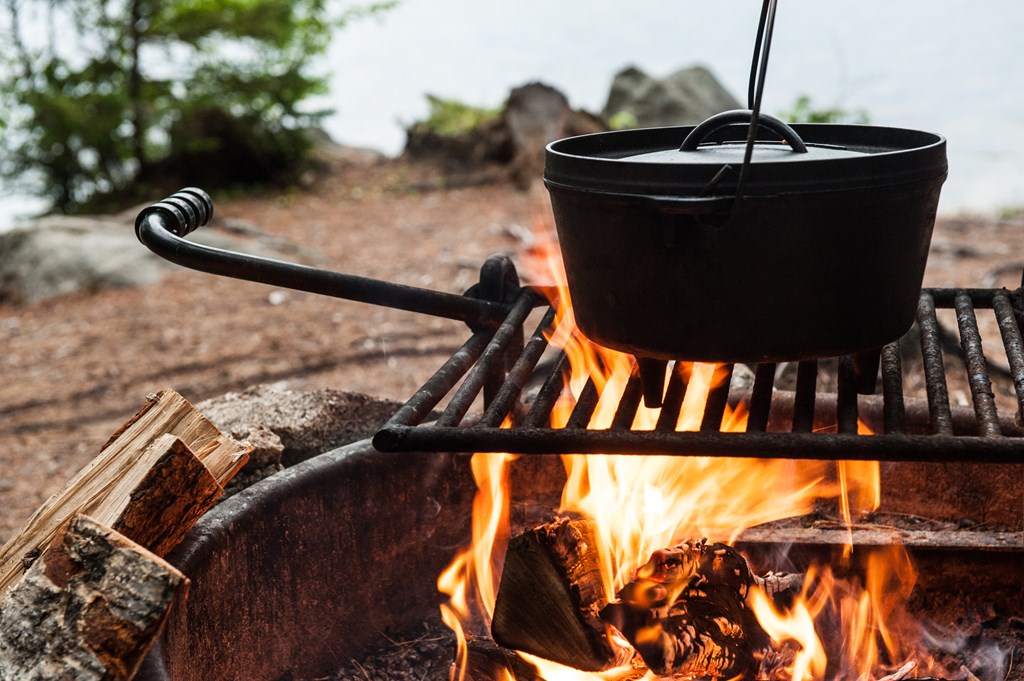
20. Apply Soap to Pots and Pans Before Cooking
If you plan to cook on a grate over the fire, your pans might get quite dirty. The burning logs often produce lots of soot, unlike your stove at home. Rather than spending all your time scouring pots clean, coat the bottom and sides with a layer of soap before cooking. The soap will keep soot from sticking to your pans during meal preparation.
After you enjoy your delicious meal, rinse the soap from the outside to reveal a clean, shiny pan. This tip is one of the best camper hacks for reducing cleaning time.
21. Make DIY Fire Starters From Everyday Home Items
Getting the first flame is the most challenging part of starting a campfire. This camping DIY hack makes it easier. Stock your camping supply kit with a few fire starters to ease the process. One method for creating firestarters involves dryer lint. Start collecting a bag of it from your dyer a few weeks before your next camping trip. Throw it into the fire as is, or place it in an egg carton with melted wax. Another method involves stuffing lint into empty toilet paper rolls.
Cotton balls also make excellent fire starters. You probably have plenty in your bathroom cupboard. Rub a few in petroleum jelly to create a batch for your next trip. Store them in a plastic bag once coated and grab one whenever you need to ignite some kindling.
22. Craft a Sit-Upon With Old Grocery Bags
When out in the woods, you may find it challenging to locate a clean, dry place to sit. A sit-upon is a simple and versatile option that gives you a place to sit wherever you go, from the campsite to a hiking trail. Begin by collecting a supply of plastic shopping bags. Once you have enough, grab a tablecloth or a large cloth grocery bag.
Stuff the plastic bags into the tablecloth or grocery bag until you have enough padding to stay comfortable when sitting down. Seal the cushion with duct tape to keep water, mud and dirt out. Choose fun duct tape patterns to create a unique style. Once you seal the sit-upon, you have a long-lasting camping solution allowing you to sit anywhere without bringing a camping chair.
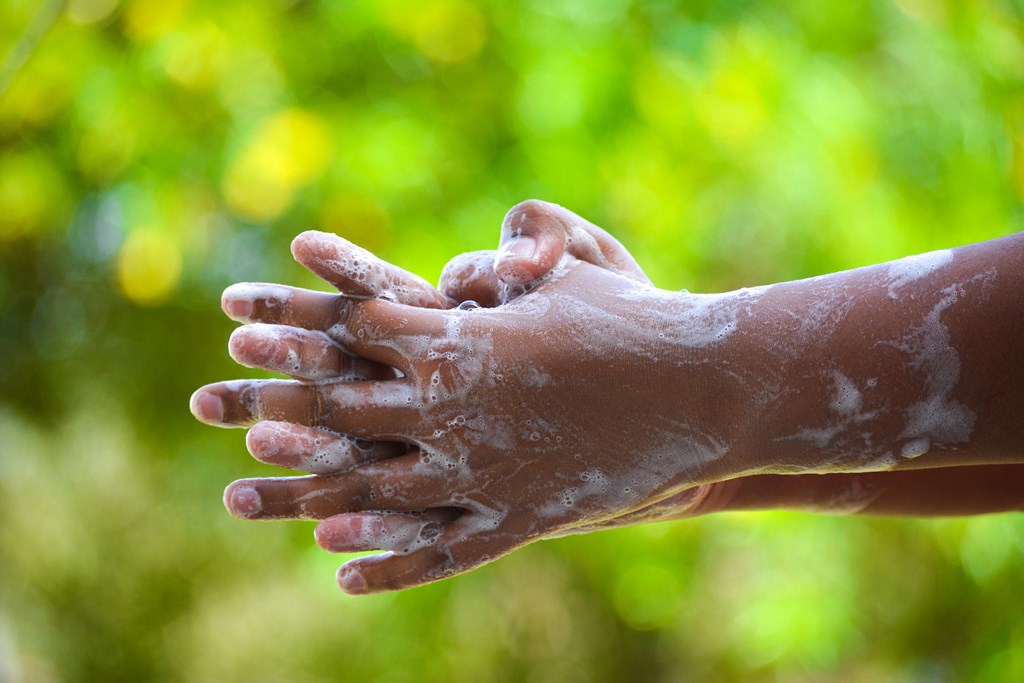
23. Use an Empty Detergent Bottle as a Hand Washing Station
When camping, you may not always have easy access to a sink. Sometimes it is impractical to run to the nearest bathhouse to wash your hands, especially in the middle of a task like cooking. Add convenience to your camping trip by making a handwashing station. Begin by collecting a detergent bottle with a spigot. If you can’t find one, use a milk jug and add a spigot.
Wash your detergent bottle thoroughly to remove any remaining cleaner. Fill it with water once you reach your campsite and place it in an accessible place, like a picnic table, with a bucket underneath to catch the water as it falls. Place some soap nearby, and you have a convenient place to wash your hands at your campsite.
24. Cook Food in an Orange Peel
Campfire cooking often presents challenges. Sometimes, you must get creative when preparing food. One way to cook food in a fire is using an orange peel. Begin with a whole orange and cut it in half. Eat the delicious slices inside, leaving behind an empty peel.
Once it is empty, use it to hold various items, from muffins to cinnamon rolls. Keep it simple by buying tubes of cinnamon rolls or a box of muffin mix. Fill one half of the peel with your filling and place the other half securely on top.
Wrap it tightly in aluminum foil and place it in the coals. Leave it there for 5 to 15 minutes, rotating once during the process. Once it is ready, take it out of the fire and unwrap it. For cinnamon rolls, top with frosting and enjoy.
25. Tie Your Travel Mug Lid and Container Together
Your travel mug is a reliable companion for camping trips, carrying everything from your morning cup of coffee to late-night hot chocolate. However, filling your mug requires you to remove the lid and place it aside. Sometimes, you may end up with a cover in the dirt. During a camping trip, you may find it difficult to clean the lid if this happens.
Ensure both pieces stay together by tying a string from your mug handle to your lid. Each time you fill the mug, the top stays nearby, preventing it from getting dirty. This hack also works well if you tend to lose lids — you will always have both close together when filling your mug.
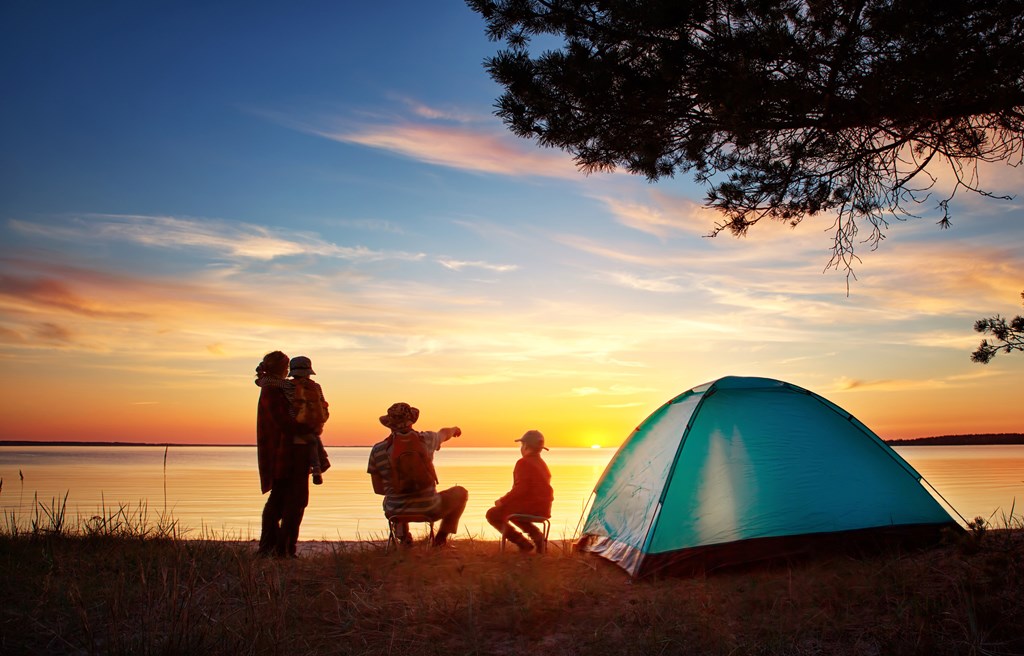
26. Mark Tent Stakes and Line With Colored Tape or Flags
When camping in a tent, the lines and stakes holding up your shelter can quickly create tripping hazards or stubbed toes. Tent lines and stakes are hard to see, especially during late-night bathroom trips. Bring colorful tape or flags to add to each tent line after you set it up. These markers will remind you to watch out as you walk around your tent. Mark tent stakes with ribbons or place rocks around them so you know where you placed each one.
Reserve Your Next Campsite Today to Try Out These Hacks
Are you already planning your next camping trip? If so, reserve a site at a KOA Campground today and start putting these camping hacks to good use. These ideas for camping made easy, combined with the quality experience of a KOA Campground, will make your next campout one to remember.
About the Author: Kampgrounds of America
Kampgrounds of America is the largest system of open-to-the-public campgrounds in the world, with over 500 locations across the United States and Canada. Founded in Billings, MT in 1962, KOA’s family of campground brands – KOA Journey, KOA Holiday and KOA Resort – today serve more than a million camping families each year. KOA is dedicated to “connecting people to the outdoors and each other” by providing people with a variety of camping experiences and the information they need to make the most of their camping trip. Read more of their camping and travel resources by visiting KOA.com/blog.



















